Most RVs are not designed to withstand long periods of very cold (or even sub-zero) temperatures. While some do come with four-season optionality and winterization package options, that does not guarantee that the internal water systems will be able to handle freezing temperatures.
This is where RV skirting comes into play. Designed to keep the undercarriage of a trailer, camper, or motorhome protected from the harsh winter cold – and the interior warm and toasty without having to run up a larger than expected heating bill.
Contents
What is RV Skirting?
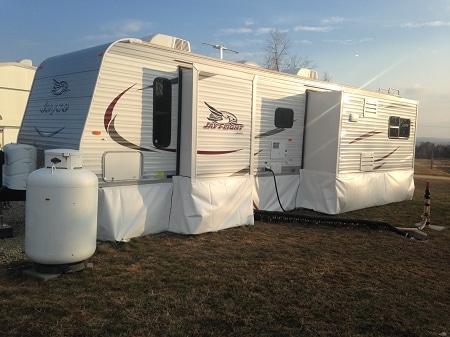
RV skirting is pretty simple. Also sometimes referred to as “wind skirting”, it is just a layer of material or insulation that is hung or packed in around the lower edge of the RV. It has been designed to help prevent the freezing cold winter air from circulating below.
Adding skirting to your RV creates a barrier from the elements, which can make a huge difference in the amount of heat loss your RV experiences. The skirting creates a pocket of warm air under the RV which helps keep the RV warmer, protects the internal plumbing systems, and can save you a bunch of cash in costly repair bills.
Rv skirting comes in a range of different options, styles, and price points – from hay bales to tarps to custom vinyl flaps. There are pros and cons associated with each option, so let’s dive in and see which will suit you best.
Why Should You Use RV Skirting?
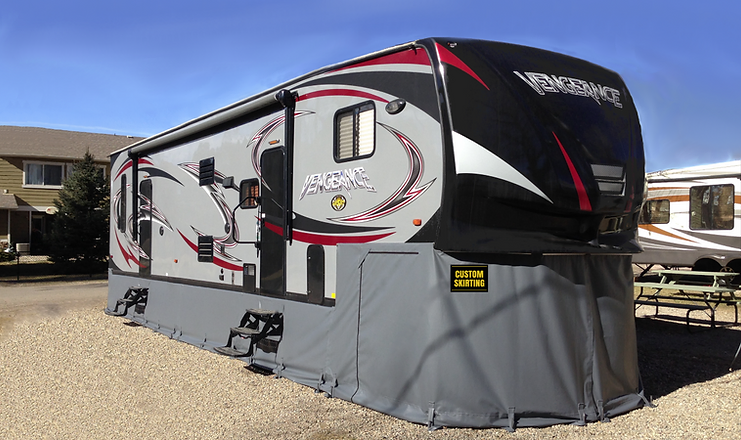
Maybe you only use your RV for weekends away. Or maybe you live in it full time. Either way, RV skirting makes cold weather RVing much more bearable. Depending on which skirting option you settle on, it can take a bit of time and effort to set up – but the results make the process worth it.
Trust me when I say it makes a huge amount of difference to the heat holding capacity of your RV. Not only is this great for your own personal comfort while inside the RV, but it is also integral in keeping your RV’s water system from freezing over.
Frozen pipes and tanks are not just annoying, but can also lead to costly repair bills as when they freeze they are prone to cracking. This also allows for you to use your water system when you wouldn’t normally be able to, you’ll save money on propane as heating efficiency bets a huge boost, you will get a bunch of extra space for storage, and it will protect your tires from the frigid temps (as long as they are also covered by the skirting)
RV skirting is an inexpensive way to help combat all of these issues.
Does RV Skirting Work?
To put in the most simple terms, hell yes!
When used in conjunction with an RV winterization kit, RV skirting will help prevent any below zero temperature issues.
Is it just useful for wintertime, though?
Nope. Skirting can also provide great insulation in the warmer months and help keep your RV cabin from overheating. Certain RV designs inherently trap heat and can quickly become slightly unbearable in the hot summer months. If this sounds like something you are used to dealing with then skirting could be a great summer and winter option.
How Much Does RV Skirting Cost?
Not the easiest question to answer as there is a whole range of variables that can affect the cost, such as:
- The type of skirting.
- The size of your RV.
- Whether it is off the rack or custom-made.
- Self-installed options are usually much cheaper than having a professional come out to install the skirting.
Custom-made vinyl RV skirting can set you back anywhere from $1200 to upwards of $7500 depending on the size of your RV, the quality of the materials used, and the company that you commission to build and install the kit.
You can save a wad of cash by DIYing your own skirting, but this can come with some obvious downsides. Ease of installation is one, properly enclosing the under-carriage is another, and homemade skirts will rarely last as long as professionally made options.
RV Skirting Options
Okay, now that we have covered all the basics, let’s take an in-depth look at all the options currently available.
Custom RV Skirting
If you can afford to splash out and get custom skirts made for your RV then I really can’t recommend against it. There are a few key reasons why custom skirting just makes sense over doing it yourself.
Firstly, the convenience. Self-built skirting can take a lot longer than you may expect. And while it may save you a decent stack of cash, there’s a good chance that you will struggle to properly insulate and completely seal off the entire area below your RV.
Next is reusability. Custom skirts are designed to be used for multiple seasons with easy setup and pack down. They are made from long-lasting, high-quality materials that are rated for many years of use and usually backed by at least some sort of warranty.
Since they are professionally designed and made, they are usually more aesthetically pleasing. I know loads of gray nomads who have made their own skirting, and while most have done a great job, you can always tell the difference between homemade and custom skirts. This might not bother you too much, but if you are a stickler for good looks then I recommend opting for custom-made skirting.
Some RV or trailer parks will only allow for custom, professionally made skirting. Ensure to check out the rules for wherever you intend to park. The more professional and pleasing to the eye the skirting is, the higher chance you have of being allowed to use them wherever you are.
There is a lower chance of accidentally damaging your RV and hurting the resale value. You may need to install hooks or snaps to hang your skirting. These could damage the chassis or paint job, and while this can happen with a custom-made option the likelihood is lowered.
Custom-made skirts are usually (not always) more environmentally friendly. This is thanks to both the material used and the fact that they can be used over and over again. Homemade skirts will often need to be replaced every year.
Are there downsides to custom-made RV skirting? Absolutely!
The initial price will obviously be way higher than DIPing yourself a skirting option, and you may have to travel long distances to get them installed by the manufacturer if you do not feel comfortable installing the skirts yourself. But, if you can afford custom-made then that is the route I suggest taking.
Prefabricated RV Skirting
EZ Snap Skirting
One of the more popular companies currently producing fully customized RV wind skirting solutions. They offer quick and easy self installation packages that use a patented “No-Drill” system featuring 3M™ extreme hold VHB adhesive.
There is no need for any specialized tools, and you don’t need any prior experience to safely install these skirts.
The “Non Fray Diamond-Weave™” vinyl skirting material is ultra rugged and offers great all season protection. It is lightweight and easy to store, and comes with a -40 degree F rating. It can be cut to any size and will fit every single RV on the market, no matter the class or shape.
EZ Snap Skirting is one of the more affordable options on the market, and usually costs considerably less than what an upholstery shop will charge. Check them out here –
https://ezsnapdirect.com/products/rv-skirting/
RV Skirting Pros
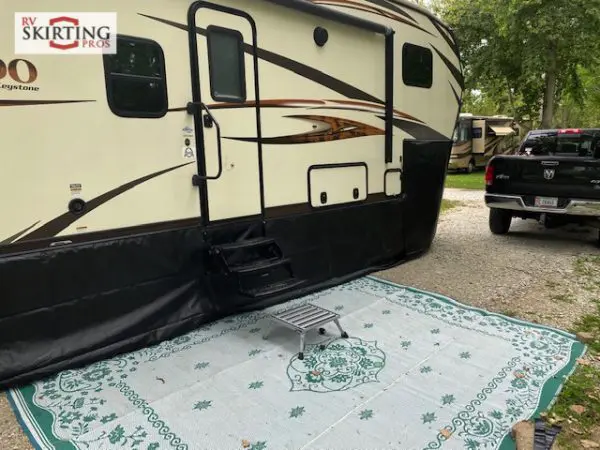
One of the up and comers in the RV wind skirting sphere, RV Skirting Pros are doing a couple of things differently.
They have a few installation options available. If you live anywhere within the Midwest states then the company will send service technicians out to you and complete the installation process. You can also choose to travel to their homebase in Indiana if you don’t live in the service area, or want to keep costs down.
The cheapest overall option is to fully self install. RV Skirting Pros will send you everything you need and a full installation guide. This process takes about half a day with the help of a friend, but will save you a nice chunk of change. The 18oz PVC coated vinyl panels come precut to 8’ long by 61″ tall. The new keder track system (commonly known as awning track,) is already center-sewn into the panels and each panel connects with high-quality velcro.
Just like EZ Snap, RV Skirting Pros use 3M’s VHB series of adhesive rivets so you do not have to drill any holes into the paneling of your RV.
https://www.rvwindskirt.com/videos.html
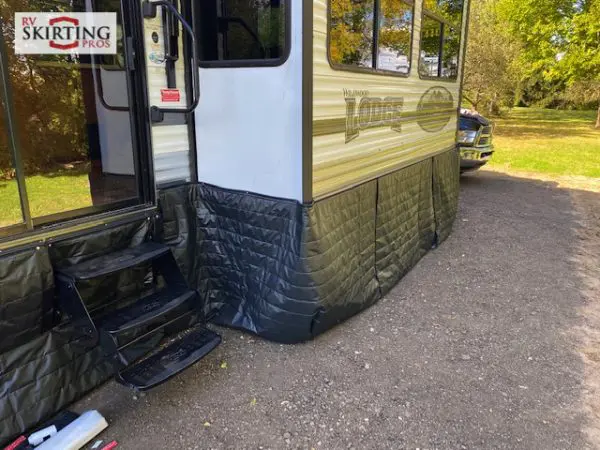
RV Wind Skirt
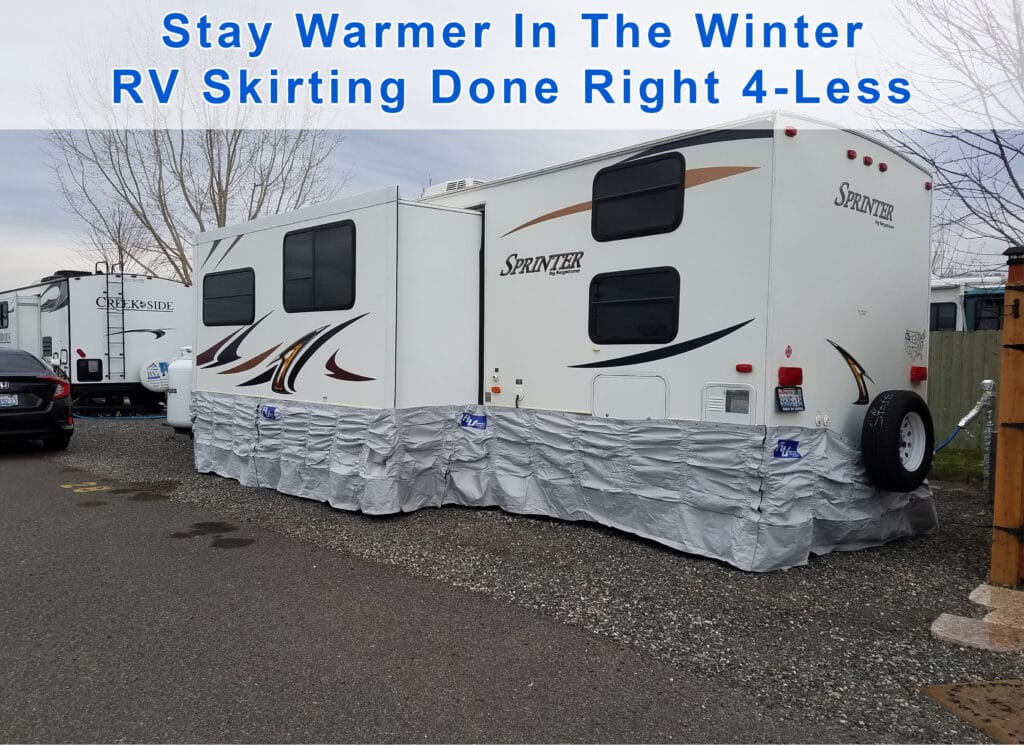
RV Wind Skirt does things a little differently. They were originally designed to deal with an issue the inventors had been battling for years – the cold wind blowing debris and sand underneath their trailer and into the area they had designated for socializing and eating.
The RV Wind Skirt is made of durable lightweight canvas material with a polymer backing. This is a thinner material than the vinyl that is usually used for Rv skirting, so if you are looking for a freeing cold winterproof option then this might not suffice.
This versatile product is great for campers looking to deal with mild winter temperatures and also the hotter summer months.
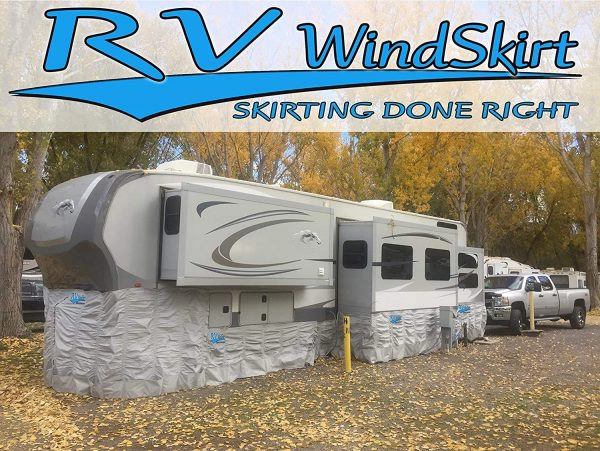
https://www.rvwindskirt.com/videos.html
AirSkirt Inflatable RV Skirting
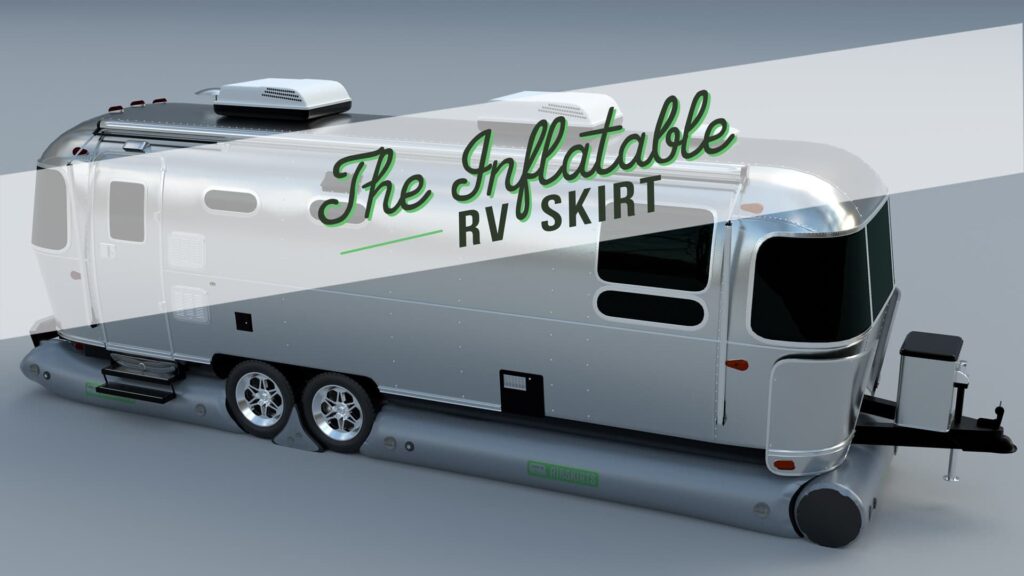
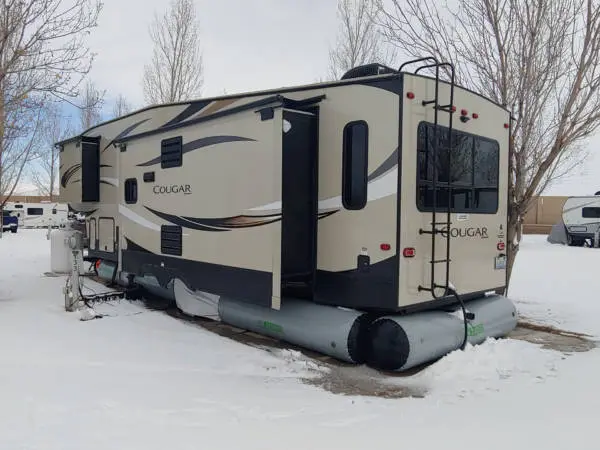
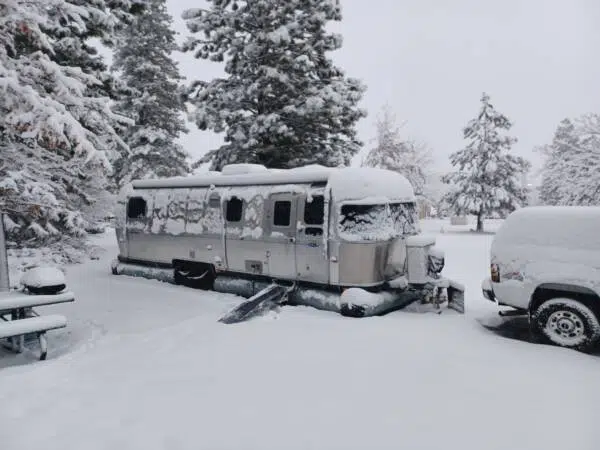
Inflatable skirting is a newer option to hit the market, and (in my opinion) the best manufacturer of these is AirSkirt Inflatable RV Skirting. They are budget-friendly, easy to install and take less than 20 minutes to set up, and have an insulating R-value factor.
They totally seal your RV’s undercarriage, are constructed from high-grade PVC material that makes it super rugged and durable, and while they are not custom-built they do come in kits that fit virtually every size RV, Camper Trailer, and 5th Wheel.
AirSkirt systems are 75% better at retaining heat than traditional RV methods. The insulation value helps keep your RV warm, blocks the driving wind, rain, and snow – and adds to your RV’s overall R-value underneath.
Budget-Friendly DIY RV Skirting Options
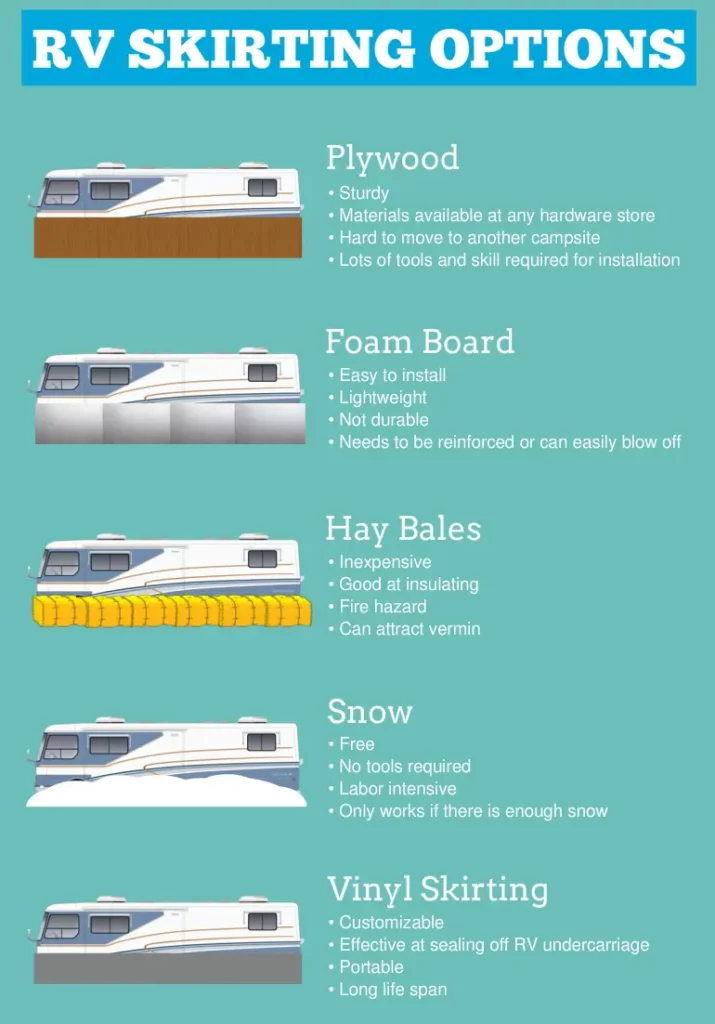
While I have just finished singing the praises of custom-made and prefabricated RV wind skirts, they are not always an option financially with most having at least slightly restrictive price points.
A quick google search will show loads of DIY RV skirting options and ideas using a wide range of different materials to get the job done. The most common at-home RV skirting solutions for travel trailers and motorhomes are:
Vinyl or Fabric RV Skirting
It is possible to buy your own vinyl, canvas, or tarpaulin and make a set of heavy-duty, rugged vinyl RV skirts without having to fork out a huge wad of money to one of the companies listed above.
Simply attach snaps or 3M plastic rivets at 1 – 2 ft intervals along the lower edge of your RV to clip the skirting to, and secure it to the ground with tent pegs. The R-value can be a little low with fabric skirting unless you choose very durable and heavy-duty material, or at least double it up.
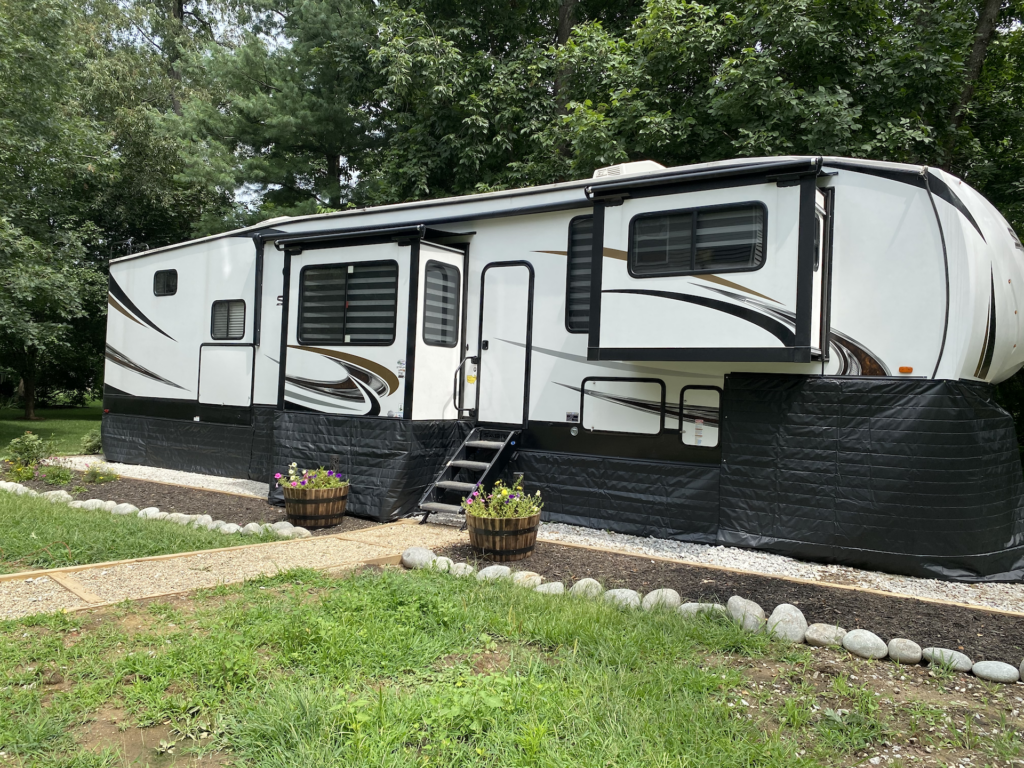
Rigid Foam Board or Plywood RV Skirting
This is one of the most popular DIY alternatives as it is cheap, and offers far better insulation than most fabric.
One glaring downside is they can be hard to install snuggly which means the wind can catch them easily opening up gaps for the cold to leak in. Many campgrounds do not allow the Rigid Foam Board or Plywood RV Skirting as they are not the most aesthetically pleasing.
Reflectix RV Skirting
Reflectix is the silver bubble wrap type material that is commonly used to insulate the front windscreen of cars. It also makes a decent DIY wind skirt for RVs as it traps heat well and is very affordable. It is made from two layers of polyethylene industrialized air bubbles bonded between two layers of aluminum polyester film.
The one major drawback is that it is quite flimsy when used by itself, but can be used in conjunction with plywood or foam boards to boost the insulating value. You can also line the underbelly of your RV with Reflectix.
This option is not the most attractive, and many RV parks will not allow it as skirting.
Hay or Straw Bales
If you are planning to batten down the hatches and park up for winter Hay or Straw Bales can make a great insulating barrier for the underside of your RV.
Straw is preferred over Hay as it is cheaper and provides a higher insulative value. It is one of the most popular materials to use as DIY RV skirting, but it does come with two major flaws – it is highly inflammable, and it can attract pests such as mice, rats, raccoons, and insects.
For these reasons, I can not recommend using Hay or Straw bales.
Snow
Think of it like an igloo for your RV. It is, without a doubt, the absolute cheapest option – but it does come with some issues.
For this method to work it needs to be cold enough for the snow to not melt, and as soon as the snow disappears so does your skirting. Great if you are in a pickle and want to cheaply and quickly insulate your RV undercarriage, but it is an unreliable fix.
RV Skirting FAQ
What Is The R-Value And What Does It Mean In Skirting?
Simply put, the R-Value of an RV skirting is the capacity of an insulating material to resist heat flow or transfer. The higher the R-Value, the better insulation it will provide.
Do You Still Have To Winterize Your RV If You Use RV Skirting?
That really depends on your situation. If you are able to adequately heat the cabin of your skirted RV then you may not need to fully winterize your RV. This comes at the risk of the heating system failing which may lead to frozen pipes and tanks, which will likely damage them.
Winterizing an RV usually involves adding some sort of anti-freeze to the water system, which while protecting the system from freezing over also disables the system from normal use. Take this all into consideration before you make any solid plans.
How Long Does It Take To Install RV Skirting?
That is totally dependent on what skirting system you use.
Most self-installation kits shouldn’t take more than half a day with the help of a friend, but if this is your first time then it may take a bit longer.
If you are looking to DIY, then it can take anywhere from a couple of hours to more than a day.
Can I Install Rv Skirting Myself?
Yes, but be ready to be a little frustrated if this is your first time!
